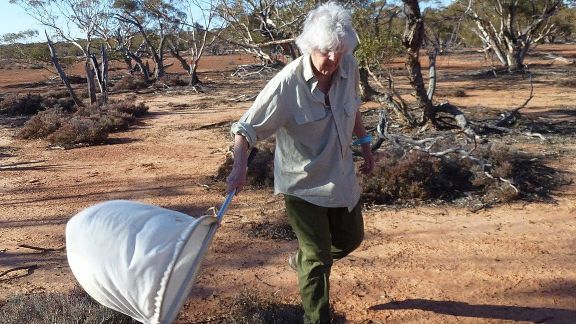Tiny Antarctic springtail named after climate activist
22 April 2020

They are tiny in stature but a newly discovered Antarctic springtail species has been named after an environmental activist making a giant impact.
The springtail, Friesea gretae, after Greta Thunberg, was named by Dr Penelope Greenslade, Honorary Research Fellow in the School of Health and Life Sciences and a renowned expert in springtails.
Springtails, scientifically known as Collembola, are just one to two millimetres long and are found throughout Australia but are inconspicuous because of their size. They live hidden in leaf litter, soil, logs and moss, and under bark and are considered “goodies” as they help decompose leaves, freeing nutrients they contain to be released so that plant roots can take them and grow.
On the frozen continent, Friesea gretae lives in moss and algae at Cape Hallett, one of the few ice-free areas on Antarctica, with some small invertebrates such as mites and nematodes – a microscopic type of worm.They cohabit with Adelie penguins and feed on rotifers and tardigrades, tiny little creatures that can survive cold, icy conditions by becoming immobile and losing moisture.
Dr Greenslade’s springtail research has seen collaborations around the world, and it was while working with colleagues at the University of Siena in Italy that she determined the species she was looking at had morphological, or visible, differences to other described species. It came down to even tinier details, like differences in length of hairs.
“With taxonomic problems like these, they're quite fun, it's like a treasure hunt really. You go chasing after anomalies – you notice an anomaly and at first you think, well is that really an anomaly or is that my imagination? Then you go a bit more into it, and you get more and more evidence to say ‘ah there is something here’,” Dr Greenslade said.
Once this was established, naming the springtail was easy.
“We scientists, especially biologists, oceanographers, botanists and meteorologists, have been documenting changes in faunas and floras in the Antarctic for quite a few years,” Dr Greenslade said.
“Climate change is particularly evident in the Antarctic because you can measure glaciers melting and so it seems appropriate to call an Antarctic species after Greta Thunberg because she's been doing such a good job of drawing attention around the world, especially among young people, to the climate change problem. So that was the reason for that.” Dr Penelope Greenslade
The publication of Friesea gretae is the latest work in springtail research for Dr Greenslade that began while living in the Solomon Islands in the 1960s. Having trained as a biochemist, Dr Greenslade was living in the South Pacific nation with her husband who was working there as an entomologist. Halfway through her PhD and with no available work in biochemistry, an opportunity arose to make collections of soil fauna for the Royal Society of London.
“As you can imagine, no one else had ever done it there, so it was all new and the material I collected was eventually deposited in the British Museum in London,” Dr Greenslade said.
“While we were in the Solomons, in our second term, an expedition came out from London, funded by the Royal Society of London and most of the people on the expedition were entomologists who were collecting soil animals. So this helped me a lot because it got me interested in Collembola and how to identify them.
“After we left the Solomons, we headed to Adelaide and I carried on because I was quite fond of these springtails by that time and no one else was looking at them anywhere in Australia, so there was an enormous opportunity for me to get involved.”
 Dr Greenslade now mainly works on Australian springtails and has described more than 200 species in her 60 years of research. She has been studying the impacts of human activities including the clearing of native vegetation for agriculture, the application of fertilisers and pesticides, wild fire and urban growth, on Australia’s unique species.
Dr Greenslade now mainly works on Australian springtails and has described more than 200 species in her 60 years of research. She has been studying the impacts of human activities including the clearing of native vegetation for agriculture, the application of fertilisers and pesticides, wild fire and urban growth, on Australia’s unique species.
And while the COVID-19 is changing working life for most, Dr Greenslade has packed her books, microscope and specimens to keep the research going from home.
“We have to do quite a lot of work. This business of looking at tiny little animals – they’re only a millimetre or two long, and you're looking at seta, their hair, on glass slides under high-powered microscopes – it's quite meticulous work and you have to keep on going back day after day to check that what you recorded the previous day was accurate,” Dr Greenslade said.
“It's fun because you'll find out something new and you're solving a problem at the same time.”


